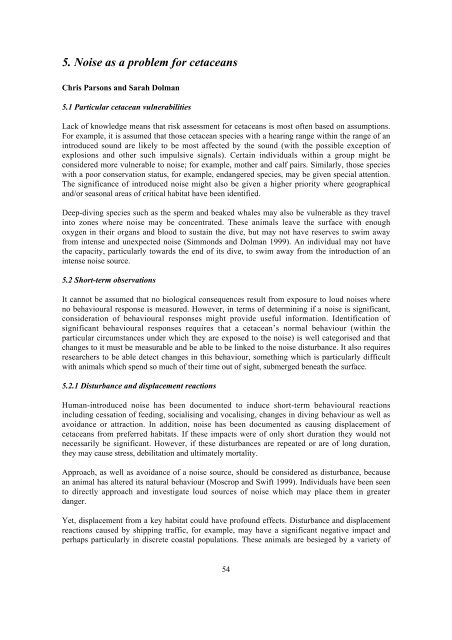Oceans of noise - Whale and Dolphin Conservation Society
Oceans of noise - Whale and Dolphin Conservation Society
Oceans of noise - Whale and Dolphin Conservation Society
- No tags were found...
You also want an ePaper? Increase the reach of your titles
YUMPU automatically turns print PDFs into web optimized ePapers that Google loves.
5. Noise as a problem for cetaceansChris Parsons <strong>and</strong> Sarah Dolman5.1 Particular cetacean vulnerabilitiesLack <strong>of</strong> knowledge means that risk assessment for cetaceans is most <strong>of</strong>ten based on assumptions.For example, it is assumed that those cetacean species with a hearing range within the range <strong>of</strong> anintroduced sound are likely to be most affected by the sound (with the possible exception <strong>of</strong>explosions <strong>and</strong> other such impulsive signals). Certain individuals within a group might beconsidered more vulnerable to <strong>noise</strong>; for example, mother <strong>and</strong> calf pairs. Similarly, those specieswith a poor conservation status, for example, endangered species, may be given special attention.The significance <strong>of</strong> introduced <strong>noise</strong> might also be given a higher priority where geographical<strong>and</strong>/or seasonal areas <strong>of</strong> critical habitat have been identified.Deep-diving species such as the sperm <strong>and</strong> beaked whales may also be vulnerable as they travelinto zones where <strong>noise</strong> may be concentrated. These animals leave the surface with enoughoxygen in their organs <strong>and</strong> blood to sustain the dive, but may not have reserves to swim awayfrom intense <strong>and</strong> unexpected <strong>noise</strong> (Simmonds <strong>and</strong> Dolman 1999). An individual may not havethe capacity, particularly towards the end <strong>of</strong> its dive, to swim away from the introduction <strong>of</strong> anintense <strong>noise</strong> source.5.2 Short-term observationsIt cannot be assumed that no biological consequences result from exposure to loud <strong>noise</strong>s whereno behavioural response is measured. However, in terms <strong>of</strong> determining if a <strong>noise</strong> is significant,consideration <strong>of</strong> behavioural responses might provide useful information. Identification <strong>of</strong>significant behavioural responses requires that a cetacean’s normal behaviour (within theparticular circumstances under which they are exposed to the <strong>noise</strong>) is well categorised <strong>and</strong> thatchanges to it must be measurable <strong>and</strong> be able to be linked to the <strong>noise</strong> disturbance. It also requiresresearchers to be able detect changes in this behaviour, something which is particularly difficultwith animals which spend so much <strong>of</strong> their time out <strong>of</strong> sight, submerged beneath the surface.5.2.1 Disturbance <strong>and</strong> displacement reactionsHuman-introduced <strong>noise</strong> has been documented to induce short-term behavioural reactionsincluding cessation <strong>of</strong> feeding, socialising <strong>and</strong> vocalising, changes in diving behaviour as well asavoidance or attraction. In addition, <strong>noise</strong> has been documented as causing displacement <strong>of</strong>cetaceans from preferred habitats. If these impacts were <strong>of</strong> only short duration they would notnecessarily be significant. However, if these disturbances are repeated or are <strong>of</strong> long duration,they may cause stress, debilitation <strong>and</strong> ultimately mortality.Approach, as well as avoidance <strong>of</strong> a <strong>noise</strong> source, should be considered as disturbance, becausean animal has altered its natural behaviour (Moscrop <strong>and</strong> Swift 1999). Individuals have been seento directly approach <strong>and</strong> investigate loud sources <strong>of</strong> <strong>noise</strong> which may place them in greaterdanger.Yet, displacement from a key habitat could have pr<strong>of</strong>ound effects. Disturbance <strong>and</strong> displacementreactions caused by shipping traffic, for example, may have a significant negative impact <strong>and</strong>perhaps particularly in discrete coastal populations. These animals are besieged by a variety <strong>of</strong>54




